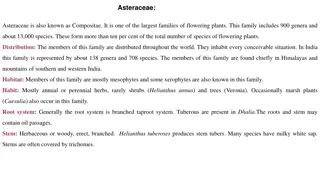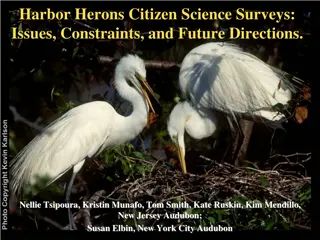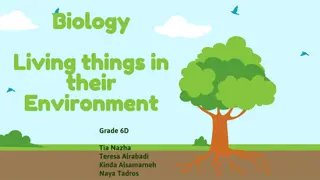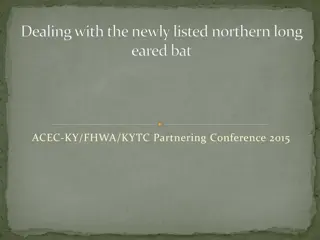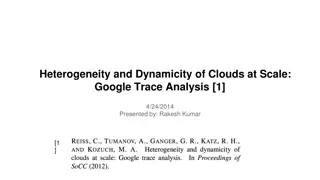Understanding Habitat Connectivity and Landscape Mosaics
Explore the importance of habitat connectivity, landscape mosaics, and metapopulations in preserving biodiversity. Delve into species loss equations, natural mosaics, and human-caused fragmentation, along with solutions. Review concepts related to optimizing land use for biodiversity and economic in
0 views • 40 slides
Understanding the Paradox of Plankton and Biodiversity Correlates
The paradox of plankton challenges the theory that the number of species should match available resources, as seen in diverse plankton ecosystems. Explanations include resource partitioning, temporal and spatial heterogeneity, predation, adaptation to disturbance, and evolutionary processes. Biodive
3 views • 40 slides
Designing a Sustainable Mars Habitat for Long-term Crew Stay
Design a Mars habitat for the first human crew that will be staying on Mars for several years. The habitat must include essential components such as sleeping quarters, restroom, exercise room, radiation shielding, food/water supply, entertainment, and ISRU technologies. Teams will research, create a
0 views • 7 slides
Insights into the Deadly Yellow Spotted Lizard
Delve into the mysterious world of the Yellow Spotted Lizard, a venomous creature known for its lethal defense mechanisms. From its appearance to habitat, learn about predators, and understand why encountering this lizard is a risky affair. Uncover the unique features of this reptile as you explore
0 views • 29 slides
Explore the Fascinating World of Habitats and Organisms in Habitat Jeopardy!
Dive into the diverse habitats and learn about living and non-living organisms with Habitat Jeopardy! Explore the characteristics of habitats like temperate forests, wetlands, and freshwater habitats. Discover the natural homes of animals, plants, and more, while testing your knowledge with exciting
0 views • 45 slides
Understanding Aquatic Adaptation in Animals
Aquatic adaptation refers to the changes in an animal's body organization to thrive in a water habitat. Vertebrates have evolved to lead partial or total aquatic lives, showcasing various adaptations. Water as a habitat offers a homogenous medium, stable conditions, and rich food resources. Aquatic
0 views • 9 slides
Adaptations and Habitat of Western Lowland Gorillas
Discover the unique adaptations of Western Lowland Gorillas including their vegetarian diet, lifespan in the wild and captivity, human-like communication abilities, and their habitat in the African Tropics Secondary Forests. Learn about the importance of conservation efforts to protect these magnifi
0 views • 8 slides
Overview of Asteraceae Family: Characteristics and Habitat
Asteraceae, also known as Compositae, is one of the largest families of flowering plants with around 13,000 species. They show diverse characteristics such as herbaceous or woody stems, simple leaves, and distinctive inflorescence types like racemose heads. This family is widely distributed globally
0 views • 12 slides
Fascinating World of Hippos: Explore Their Habitat and Adaptations!
Delve into the intriguing world of hippos as we uncover their lifestyle, habitat, and unique adaptations. Discover how these majestic creatures thrive in Africa, their lazy reputation, and the mesmerizing aspects of their underwater life. From baby hippos bonding with their mothers to adult hippos f
1 views • 14 slides
Environmental Impacts of Fishing: Habitat Damage and Bycatch
Fishing can negatively impact the marine environment through habitat damage and bycatch. Habitat damage occurs when fishing gear harms delicate seafloor habitats where endangered species grow. Bycatch, or unwanted catch, involves unintentionally capturing marine species like whales, dolphins, and se
0 views • 4 slides
Reclamation Habitat Improvement Projects Overview
Reclamation focuses on habitat improvement projects in specific river basins, collaborating with various stakeholders and entities. They undertake around 25 projects annually, with a shift towards implementing projects in the Lemhi, Pahsimeroi, and Upper Salmon areas. Management is meticulous, with
0 views • 9 slides
Impact of Habitat for Humanity Homeownership on Quality of Life
A study by Wilder Research on Habitat for Humanity homeowners in Minnesota reveals positive impacts on safety, health, education, social connectedness, family interaction, personal well-being, and economic situation. Results show improved quality of life, with high levels of satisfaction and safety
0 views • 13 slides
Protecting Southeast Asian Songbirds: Conservation Efforts and Challenges
Southeast Asian songbirds face threats such as habitat loss, illegal capture for the pet trade, and hunting. Conservation efforts are vital to protect these species from further decline. Awareness, enforcement of laws, and habitat restoration can help save these beautiful birds from extinction.
0 views • 32 slides
Challenges and Solutions in Harbor Herons Citizen Science Surveys
The Citizen Science Surveys regarding harbor herons face various challenges such as habitat assessments, effects of tides, distance issues, and discrepancies in data entry. Volunteer input, carefully crafted protocols, and maintaining contact with volunteers help in addressing these challenges. Solu
0 views • 29 slides
Threats to Wildlife Conservation: Understanding Extinction Causes
Animals face extinction due to genetic factors, habitat destruction, invasive species, global warming, hunting, and illegal trade. Black rhinos are critically endangered mainly due to poaching and habitat loss. Tree kangaroos and rockhopper penguins are also at risk due to habitat degradation and cl
0 views • 6 slides
Legal Analysis of Gopher Frog Habitat Determination
Professor Edward Richards from LSU Law School discusses the potential constitutional issues raised by the designation of critical habitat for the gopher frog. The analysis includes examining interstate commerce issues, regulatory takings, wetlands permitting under the CWA, and the proper designation
0 views • 11 slides
Discover the Ecosystem of Debs Park: From the Mountains to the City
Explore the unique ecosystem of Debs Park, transitioning from mountain landscapes to an urban setting. Learn about key terms like biodiversity, habitat, and plant communities, with a focus on the shrubby woodland and diverse plant species found in this Californian habitat.
0 views • 26 slides
Arctic Habitat and Polar Bears: A Conservation Perspective
The Arctic habitat, home to diverse plants and animals like polar bears, faces threats such as climate change, toxic pollution, and oil exploration. Despite past population growth, polar bear numbers are now estimated to be between 22,000 to 31,000. Conservation efforts by Scandinavian countries hav
1 views • 6 slides
Exploring the Life Cycle and Habitat of a Grizzly Bear
Delve into the fascinating life cycle and habitat of grizzly bears, from their varied habitats encompassing grasslands, tundra, and more, to their adaptations, diet, and behavior such as eating berries, roots, fish, and even deer. Discover how grizzly bear cubs differ from adults and the aggressive
0 views • 8 slides
Tidal Waters Fish Habitat Assessment Choptank Framework Pilot Fish GIT Meeting January 2021
The Tidal Waters Fish Habitat Assessment Choptank Framework Pilot Fish GIT Meeting held in January 2021 discussed background, drivers, and the selection of the Choptank River as a candidate tributary. The project team, responsible parties, actions, and timeline for developing an analytical framework
0 views • 17 slides
Factors Influencing Fish Habitat in Chesapeake Bay Watershed Workshop Report
This workshop report delves into the factors affecting fish habitat function in the Chesapeake Bay Watershed, focusing on headwaters, nontidal, tidal, and mainstem areas. It outlines the workshop process, assessment frameworks, and user needs to support restoration and management decisions. The repo
1 views • 31 slides
Dockside Park Sustainable Shorelines Demonstration Project
Dockside Park in Cold Spring, NY, is a sustainable shorelines project that aims to stabilize park property while balancing human use with habitat preservation and improvement. The project started in 2005 and has received support for research, guidance, and outreach. It involves mimicking natural sho
0 views • 14 slides
Riparian Area Management Regulations and Standards Overview
Riparian area management has evolved over the years with regulations addressing timber harvest impacts on fish habitat and water quality. Key aspects include protection standards, considerations of economic feasibility, and the importance of preserving fish habitat for sustainable ecosystem health.
0 views • 55 slides
The Fascinating Malayan Tapir: Habitat, Range, and Adaptations
The Malayan tapir, the largest of its kind, is uniquely adapted to its habitat in tropical lowland swamps, montane and hill forests. With its distinctive black and white color pattern for camouflage and a prehensile snout for feeding and communication, this species thrives in Myanmar, Thailand, Mala
0 views • 26 slides
Challenges in Data Integration: Heterogeneity and Solutions
Data integration faces challenges such as value heterogeneity, instance heterogeneity, and structure heterogeneity. Existing solutions assume independence of data sources and utilize methods like data fusion, truth discovery, string matching, object matching, schema matching, and model management. T
0 views • 5 slides
Understanding Organism Habitat Suitability Through Abiotic Factors
Explore the relationship between organisms and their habitats based on abiotic factors like pH, temperature, light intensity, and more. Learn how to measure and relate these factors to the organisms' choice of habitat, with practical investigation procedures and result analysis provided.
0 views • 59 slides
Exploring the Northern Long-Eared Bat: Habitat, Range, and Conservation Status
Discover the fascinating world of the northern long-eared bat (NLEB) through insights on its range, appearance, habitat preferences, and conservation status. Learn about its roosting habits, distribution across states, and the challenges it faces as a threatened species. Delve into the complexities
0 views • 25 slides
Threats to Biodiversity: Habitat Loss and Conservation Efforts
Habitat loss is a significant threat to species worldwide, with forests, swamps, plains, and other habitats disappearing due to human activities. The decline of black rhinos and the conservation efforts made to protect them illustrate the impact of such activities on wildlife populations. African Pa
2 views • 12 slides
Understanding Fish Migration Patterns and Behaviors
Fish migration involves the movement of aquatic animals for various purposes such as feeding, reproduction, and habitat changes. This article explores different types of fish migration, including shoaling, schooling, and various migration patterns based on habitat changes. From freshwater to marine
0 views • 22 slides
Understanding Algae: Classification, Habitat, and Reproduction
Algae are chlorophyllous thallophytes that thrive in aquatic environments, producing their own food and oxygen through photosynthesis. They are categorized based on habitat as aquatic, terrestrial, aerophytes, cryophytes, and thermophytes. The three main classifications of algae are Chlorophyceae (g
0 views • 16 slides
Habitat Restoration and Protection Initiatives in SW Washington: Costs and Benefits
Restoration and protection efforts for various habitat scenarios, including non-working land restoration and working land habitat protection in Southwest Washington. The activities for prairie restoration on Scotch Broom infested land are detailed, along with costs associated with restoring prairie
0 views • 24 slides
Understanding Dangers to Animals: Predators and Habitat Loss
Animals face various dangers in their natural habitats, including predators and habitat loss. Predators like owls, bobcats, and racoons hunt other animals, while habitat loss, such as the melting Arctic ice cap, threatens species like polar bears. Human activities, like beach development, also impac
0 views • 19 slides
Elk Creek Wood Replacement Project Overview
This project, led by the Oregon Watershed Enhancement Board in 2009 and documented by Katie Halvorson, focuses on the replacement of wood structures in Elk Creek to enhance watershed function and habitat complexity for juvenile coho salmon. By addressing the lack of large wood, the initiative aims t
0 views • 20 slides
Challenges and Design of EOSC Service Portfolio Management
Challenges faced in managing the European Open Science Cloud (EOSC) service portfolio include federated settings, provider heterogeneity, consumer heterogeneity, and balancing service quality with inclusiveness. The design aims to augment existing ITSM frameworks with EOSC-specific processes while a
0 views • 16 slides
Understanding Isotope Heterogeneity in Solar Protoplanetary Disk
Explore the origin of s-process isotope heterogeneity in the solar protoplanetary disk, delving into cosmochemistry, isotopic variations in meteorites, and the significance of internal normalization. Discover the correlation between Pd isotope compositions in iron meteorites and the solar system s-p
0 views • 17 slides
Inspiring Faith and Service: Habitat for Humanity's Christian Mission
Explore the journey of Habitat for Humanity, a global Christian organization dedicated to putting love into action by building homes, communities, and hope. Through faith, humility, and a commitment to serving others, Habitat demonstrates the teachings of Jesus and invites individuals of all backgro
0 views • 12 slides
Understanding Cloud Heterogeneity and Dynamicity: A Google Trace Analysis
Exploring the heterogeneity and dynamic nature of clouds at scale using Google Trace Analysis, focusing on machine allocation, workload types, job durations, task shapes, and machine churn. The study offers insights into resource allocation in evolving multi-tenant clusters and highlights the challe
0 views • 16 slides
Enhancing GPGPU Performance through Inter-Warp Heterogeneity Exploitation
This research focuses on addressing memory divergence issues in GPGPUs by exploiting inter-warp heterogeneity. By prioritizing mostly-hit warps and deprioritizing mostly-miss warps through Memory Divergence Correction (MeDiC), significant performance and energy efficiency improvements were achieved
0 views • 45 slides
Impact Evaluation of UN-Habitat's Housing Approach 2008-2019
The Impact Evaluation of UN-Habitat's Housing Approach assessed the impact of UN-Habitat's efforts in providing adequate, affordable housing, and reducing urban poverty between 2008-2019. The evaluation included regional and country reports, focusing on the effects and impacts of UN-Habitat's Housin
0 views • 14 slides
Analysis of Discourse Styles in Therapeutic Conversations by Labov and Fanshel
Labov and Fanshel's non-critical approach to discourse analysis focuses on the heterogeneity of conversation styles, emphasizing shifts between frames and the importance of paralinguistic cues in therapeutic discourse. They identify different styles associated with various frames, such as interview
0 views • 14 slides







